Leadership Challenges: Cases of Wana Electricals and Kewarra Resort
VerifiedAdded on 2023/01/20
|8
|2358
|36
Case Study
AI Summary
This case study analyzes two distinct leadership scenarios. The first case examines Wana Electricals, a company facing challenges due to globalization and internal resistance to change, where the CEO attempts to implement transformational and situational leadership. The second case focuses on Kewarra Island Resort, dealing with cultural discrimination between aboriginal and white Australian employees, and the HR manager's efforts to address the issue through LMX and power/influence leadership approaches. Both cases provide insights into leadership theories and their practical applications in resolving organizational conflicts, promoting employee motivation, and fostering a positive work environment. The document explores the application of various leadership styles, including transactional, transformational, situational, LMX, and power/influence leadership, to address specific challenges related to organizational restructuring, employee discrimination, and cultural integration. The case studies highlight the importance of adapting leadership styles to specific situations and the impact of leadership on organizational outcomes.
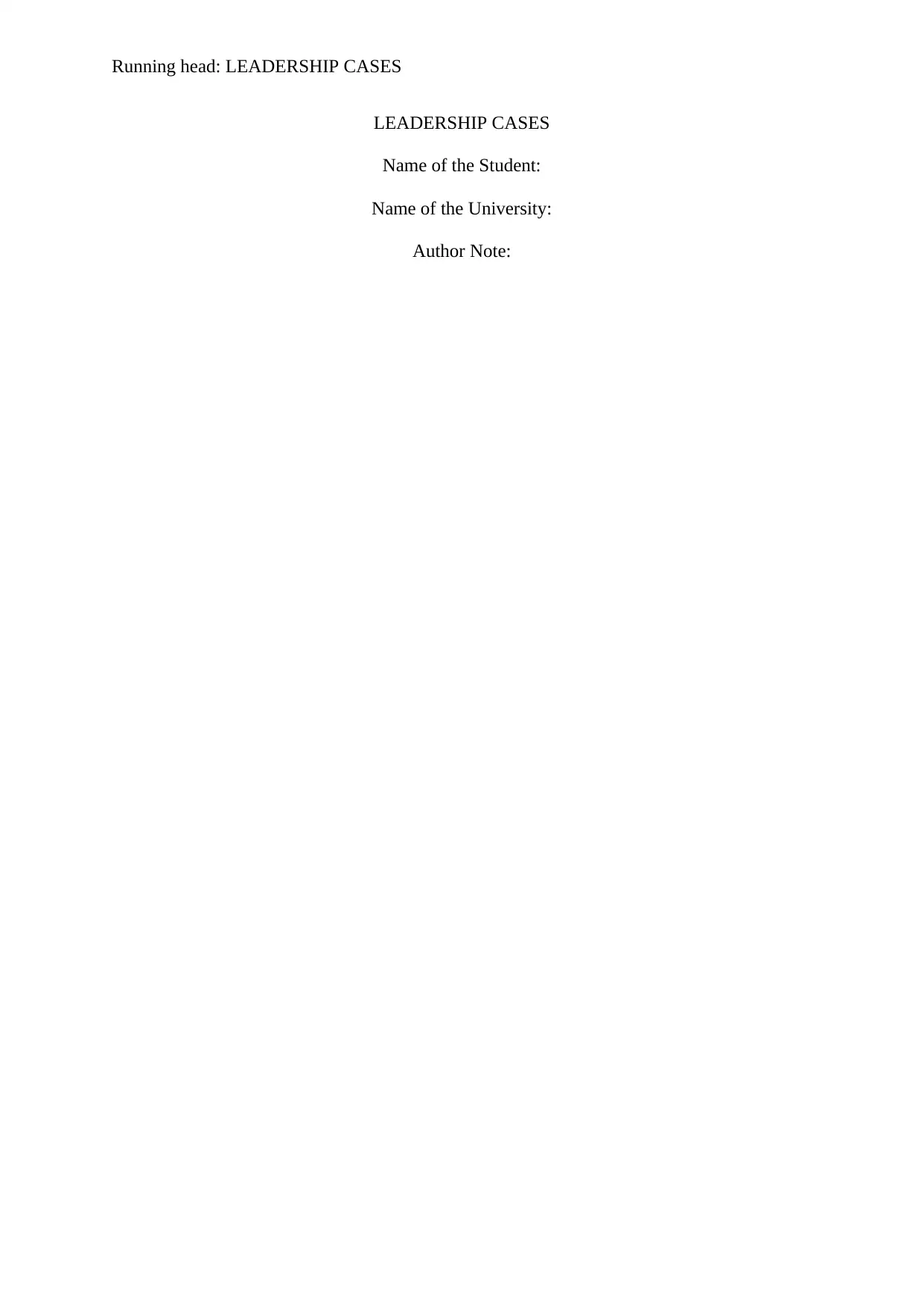
Running head: LEADERSHIP CASES
LEADERSHIP CASES
Name of the Student:
Name of the University:
Author Note:
LEADERSHIP CASES
Name of the Student:
Name of the University:
Author Note:
Paraphrase This Document
Need a fresh take? Get an instant paraphrase of this document with our AI Paraphraser
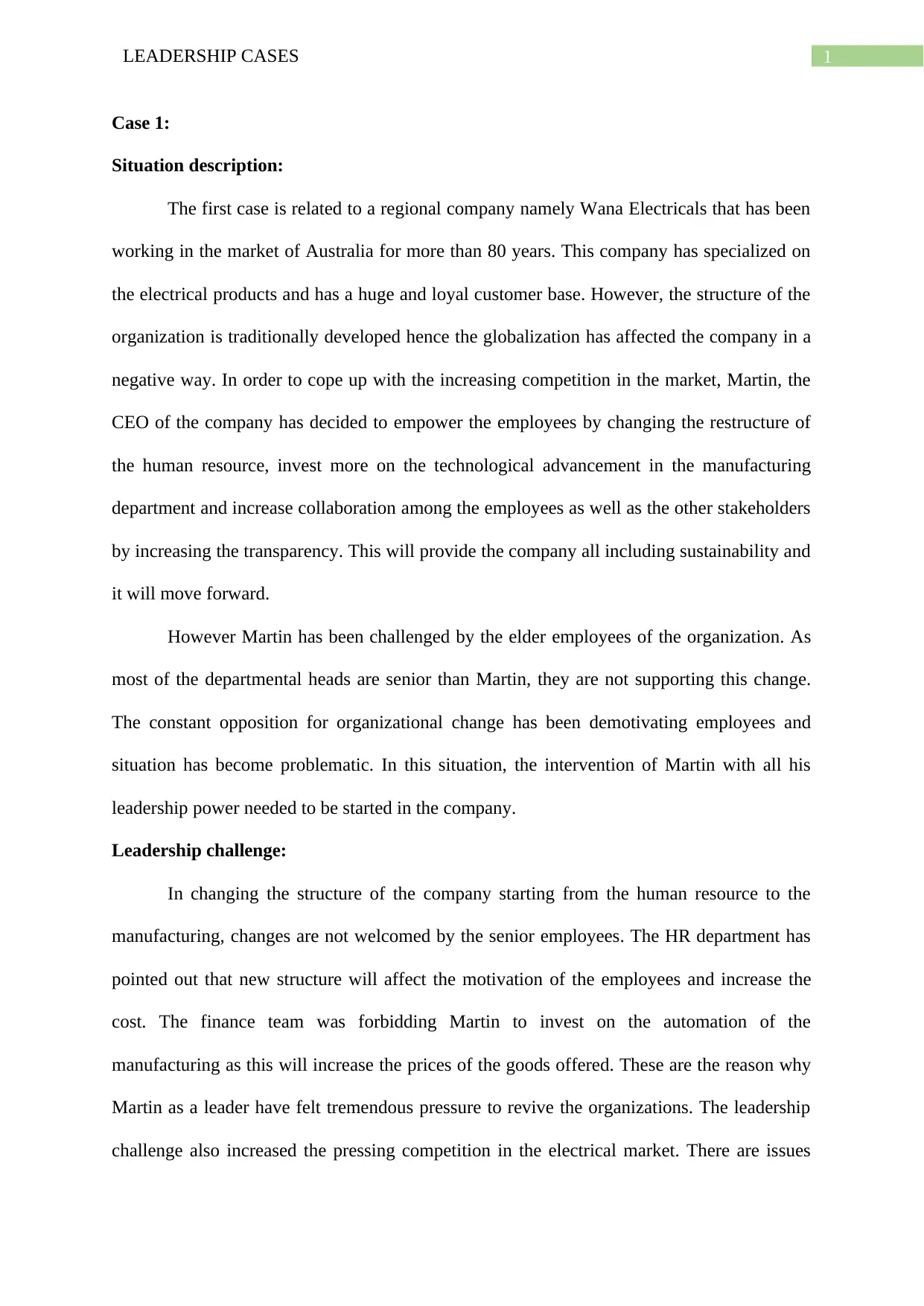
1LEADERSHIP CASES
Case 1:
Situation description:
The first case is related to a regional company namely Wana Electricals that has been
working in the market of Australia for more than 80 years. This company has specialized on
the electrical products and has a huge and loyal customer base. However, the structure of the
organization is traditionally developed hence the globalization has affected the company in a
negative way. In order to cope up with the increasing competition in the market, Martin, the
CEO of the company has decided to empower the employees by changing the restructure of
the human resource, invest more on the technological advancement in the manufacturing
department and increase collaboration among the employees as well as the other stakeholders
by increasing the transparency. This will provide the company all including sustainability and
it will move forward.
However Martin has been challenged by the elder employees of the organization. As
most of the departmental heads are senior than Martin, they are not supporting this change.
The constant opposition for organizational change has been demotivating employees and
situation has become problematic. In this situation, the intervention of Martin with all his
leadership power needed to be started in the company.
Leadership challenge:
In changing the structure of the company starting from the human resource to the
manufacturing, changes are not welcomed by the senior employees. The HR department has
pointed out that new structure will affect the motivation of the employees and increase the
cost. The finance team was forbidding Martin to invest on the automation of the
manufacturing as this will increase the prices of the goods offered. These are the reason why
Martin as a leader have felt tremendous pressure to revive the organizations. The leadership
challenge also increased the pressing competition in the electrical market. There are issues
Case 1:
Situation description:
The first case is related to a regional company namely Wana Electricals that has been
working in the market of Australia for more than 80 years. This company has specialized on
the electrical products and has a huge and loyal customer base. However, the structure of the
organization is traditionally developed hence the globalization has affected the company in a
negative way. In order to cope up with the increasing competition in the market, Martin, the
CEO of the company has decided to empower the employees by changing the restructure of
the human resource, invest more on the technological advancement in the manufacturing
department and increase collaboration among the employees as well as the other stakeholders
by increasing the transparency. This will provide the company all including sustainability and
it will move forward.
However Martin has been challenged by the elder employees of the organization. As
most of the departmental heads are senior than Martin, they are not supporting this change.
The constant opposition for organizational change has been demotivating employees and
situation has become problematic. In this situation, the intervention of Martin with all his
leadership power needed to be started in the company.
Leadership challenge:
In changing the structure of the company starting from the human resource to the
manufacturing, changes are not welcomed by the senior employees. The HR department has
pointed out that new structure will affect the motivation of the employees and increase the
cost. The finance team was forbidding Martin to invest on the automation of the
manufacturing as this will increase the prices of the goods offered. These are the reason why
Martin as a leader have felt tremendous pressure to revive the organizations. The leadership
challenge also increased the pressing competition in the electrical market. There are issues
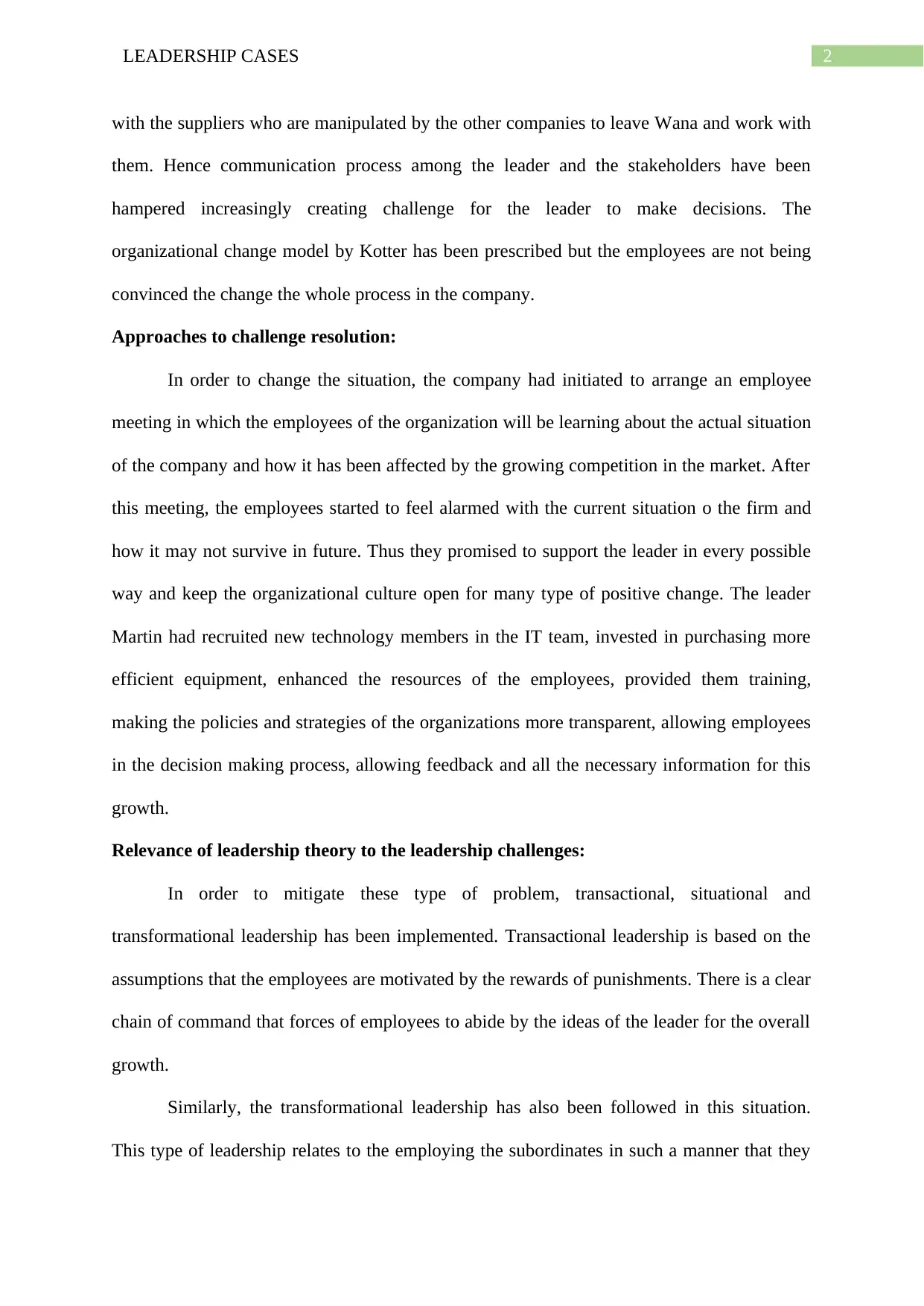
2LEADERSHIP CASES
with the suppliers who are manipulated by the other companies to leave Wana and work with
them. Hence communication process among the leader and the stakeholders have been
hampered increasingly creating challenge for the leader to make decisions. The
organizational change model by Kotter has been prescribed but the employees are not being
convinced the change the whole process in the company.
Approaches to challenge resolution:
In order to change the situation, the company had initiated to arrange an employee
meeting in which the employees of the organization will be learning about the actual situation
of the company and how it has been affected by the growing competition in the market. After
this meeting, the employees started to feel alarmed with the current situation o the firm and
how it may not survive in future. Thus they promised to support the leader in every possible
way and keep the organizational culture open for many type of positive change. The leader
Martin had recruited new technology members in the IT team, invested in purchasing more
efficient equipment, enhanced the resources of the employees, provided them training,
making the policies and strategies of the organizations more transparent, allowing employees
in the decision making process, allowing feedback and all the necessary information for this
growth.
Relevance of leadership theory to the leadership challenges:
In order to mitigate these type of problem, transactional, situational and
transformational leadership has been implemented. Transactional leadership is based on the
assumptions that the employees are motivated by the rewards of punishments. There is a clear
chain of command that forces of employees to abide by the ideas of the leader for the overall
growth.
Similarly, the transformational leadership has also been followed in this situation.
This type of leadership relates to the employing the subordinates in such a manner that they
with the suppliers who are manipulated by the other companies to leave Wana and work with
them. Hence communication process among the leader and the stakeholders have been
hampered increasingly creating challenge for the leader to make decisions. The
organizational change model by Kotter has been prescribed but the employees are not being
convinced the change the whole process in the company.
Approaches to challenge resolution:
In order to change the situation, the company had initiated to arrange an employee
meeting in which the employees of the organization will be learning about the actual situation
of the company and how it has been affected by the growing competition in the market. After
this meeting, the employees started to feel alarmed with the current situation o the firm and
how it may not survive in future. Thus they promised to support the leader in every possible
way and keep the organizational culture open for many type of positive change. The leader
Martin had recruited new technology members in the IT team, invested in purchasing more
efficient equipment, enhanced the resources of the employees, provided them training,
making the policies and strategies of the organizations more transparent, allowing employees
in the decision making process, allowing feedback and all the necessary information for this
growth.
Relevance of leadership theory to the leadership challenges:
In order to mitigate these type of problem, transactional, situational and
transformational leadership has been implemented. Transactional leadership is based on the
assumptions that the employees are motivated by the rewards of punishments. There is a clear
chain of command that forces of employees to abide by the ideas of the leader for the overall
growth.
Similarly, the transformational leadership has also been followed in this situation.
This type of leadership relates to the employing the subordinates in such a manner that they
⊘ This is a preview!⊘
Do you want full access?
Subscribe today to unlock all pages.

Trusted by 1+ million students worldwide
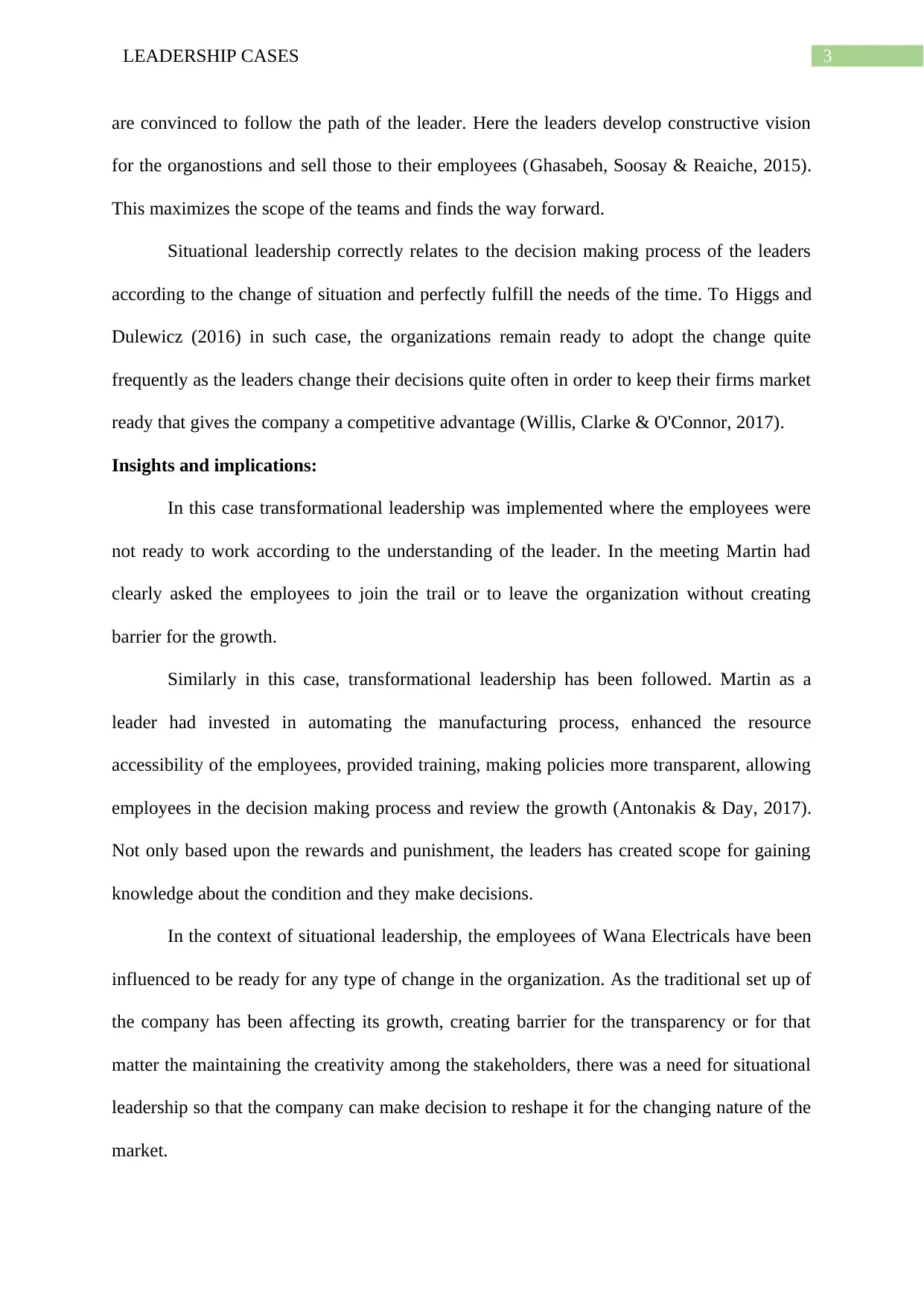
3LEADERSHIP CASES
are convinced to follow the path of the leader. Here the leaders develop constructive vision
for the organostions and sell those to their employees (Ghasabeh, Soosay & Reaiche, 2015).
This maximizes the scope of the teams and finds the way forward.
Situational leadership correctly relates to the decision making process of the leaders
according to the change of situation and perfectly fulfill the needs of the time. To Higgs and
Dulewicz (2016) in such case, the organizations remain ready to adopt the change quite
frequently as the leaders change their decisions quite often in order to keep their firms market
ready that gives the company a competitive advantage (Willis, Clarke & O'Connor, 2017).
Insights and implications:
In this case transformational leadership was implemented where the employees were
not ready to work according to the understanding of the leader. In the meeting Martin had
clearly asked the employees to join the trail or to leave the organization without creating
barrier for the growth.
Similarly in this case, transformational leadership has been followed. Martin as a
leader had invested in automating the manufacturing process, enhanced the resource
accessibility of the employees, provided training, making policies more transparent, allowing
employees in the decision making process and review the growth (Antonakis & Day, 2017).
Not only based upon the rewards and punishment, the leaders has created scope for gaining
knowledge about the condition and they make decisions.
In the context of situational leadership, the employees of Wana Electricals have been
influenced to be ready for any type of change in the organization. As the traditional set up of
the company has been affecting its growth, creating barrier for the transparency or for that
matter the maintaining the creativity among the stakeholders, there was a need for situational
leadership so that the company can make decision to reshape it for the changing nature of the
market.
are convinced to follow the path of the leader. Here the leaders develop constructive vision
for the organostions and sell those to their employees (Ghasabeh, Soosay & Reaiche, 2015).
This maximizes the scope of the teams and finds the way forward.
Situational leadership correctly relates to the decision making process of the leaders
according to the change of situation and perfectly fulfill the needs of the time. To Higgs and
Dulewicz (2016) in such case, the organizations remain ready to adopt the change quite
frequently as the leaders change their decisions quite often in order to keep their firms market
ready that gives the company a competitive advantage (Willis, Clarke & O'Connor, 2017).
Insights and implications:
In this case transformational leadership was implemented where the employees were
not ready to work according to the understanding of the leader. In the meeting Martin had
clearly asked the employees to join the trail or to leave the organization without creating
barrier for the growth.
Similarly in this case, transformational leadership has been followed. Martin as a
leader had invested in automating the manufacturing process, enhanced the resource
accessibility of the employees, provided training, making policies more transparent, allowing
employees in the decision making process and review the growth (Antonakis & Day, 2017).
Not only based upon the rewards and punishment, the leaders has created scope for gaining
knowledge about the condition and they make decisions.
In the context of situational leadership, the employees of Wana Electricals have been
influenced to be ready for any type of change in the organization. As the traditional set up of
the company has been affecting its growth, creating barrier for the transparency or for that
matter the maintaining the creativity among the stakeholders, there was a need for situational
leadership so that the company can make decision to reshape it for the changing nature of the
market.
Paraphrase This Document
Need a fresh take? Get an instant paraphrase of this document with our AI Paraphraser
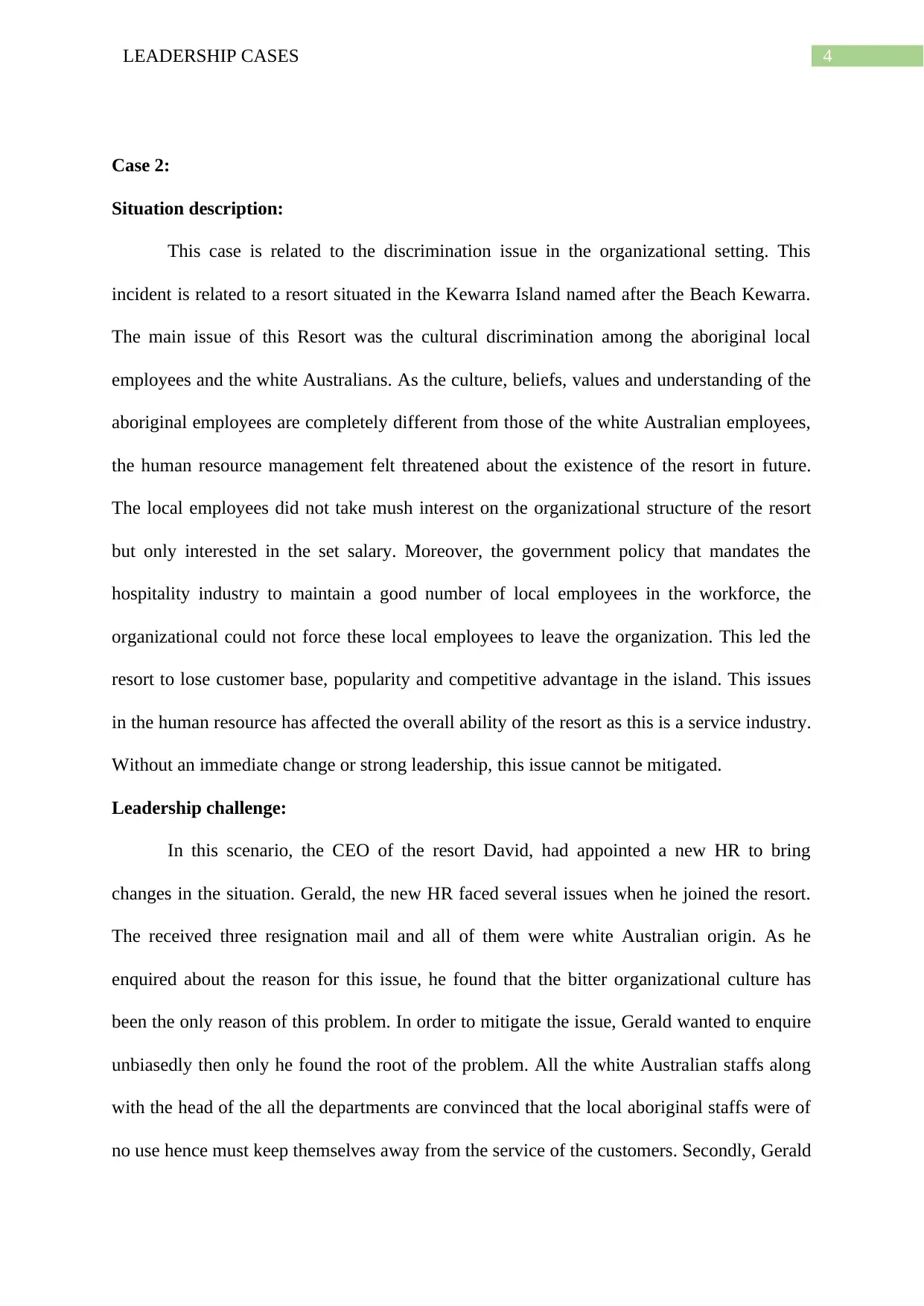
4LEADERSHIP CASES
Case 2:
Situation description:
This case is related to the discrimination issue in the organizational setting. This
incident is related to a resort situated in the Kewarra Island named after the Beach Kewarra.
The main issue of this Resort was the cultural discrimination among the aboriginal local
employees and the white Australians. As the culture, beliefs, values and understanding of the
aboriginal employees are completely different from those of the white Australian employees,
the human resource management felt threatened about the existence of the resort in future.
The local employees did not take mush interest on the organizational structure of the resort
but only interested in the set salary. Moreover, the government policy that mandates the
hospitality industry to maintain a good number of local employees in the workforce, the
organizational could not force these local employees to leave the organization. This led the
resort to lose customer base, popularity and competitive advantage in the island. This issues
in the human resource has affected the overall ability of the resort as this is a service industry.
Without an immediate change or strong leadership, this issue cannot be mitigated.
Leadership challenge:
In this scenario, the CEO of the resort David, had appointed a new HR to bring
changes in the situation. Gerald, the new HR faced several issues when he joined the resort.
The received three resignation mail and all of them were white Australian origin. As he
enquired about the reason for this issue, he found that the bitter organizational culture has
been the only reason of this problem. In order to mitigate the issue, Gerald wanted to enquire
unbiasedly then only he found the root of the problem. All the white Australian staffs along
with the head of the all the departments are convinced that the local aboriginal staffs were of
no use hence must keep themselves away from the service of the customers. Secondly, Gerald
Case 2:
Situation description:
This case is related to the discrimination issue in the organizational setting. This
incident is related to a resort situated in the Kewarra Island named after the Beach Kewarra.
The main issue of this Resort was the cultural discrimination among the aboriginal local
employees and the white Australians. As the culture, beliefs, values and understanding of the
aboriginal employees are completely different from those of the white Australian employees,
the human resource management felt threatened about the existence of the resort in future.
The local employees did not take mush interest on the organizational structure of the resort
but only interested in the set salary. Moreover, the government policy that mandates the
hospitality industry to maintain a good number of local employees in the workforce, the
organizational could not force these local employees to leave the organization. This led the
resort to lose customer base, popularity and competitive advantage in the island. This issues
in the human resource has affected the overall ability of the resort as this is a service industry.
Without an immediate change or strong leadership, this issue cannot be mitigated.
Leadership challenge:
In this scenario, the CEO of the resort David, had appointed a new HR to bring
changes in the situation. Gerald, the new HR faced several issues when he joined the resort.
The received three resignation mail and all of them were white Australian origin. As he
enquired about the reason for this issue, he found that the bitter organizational culture has
been the only reason of this problem. In order to mitigate the issue, Gerald wanted to enquire
unbiasedly then only he found the root of the problem. All the white Australian staffs along
with the head of the all the departments are convinced that the local aboriginal staffs were of
no use hence must keep themselves away from the service of the customers. Secondly, Gerald
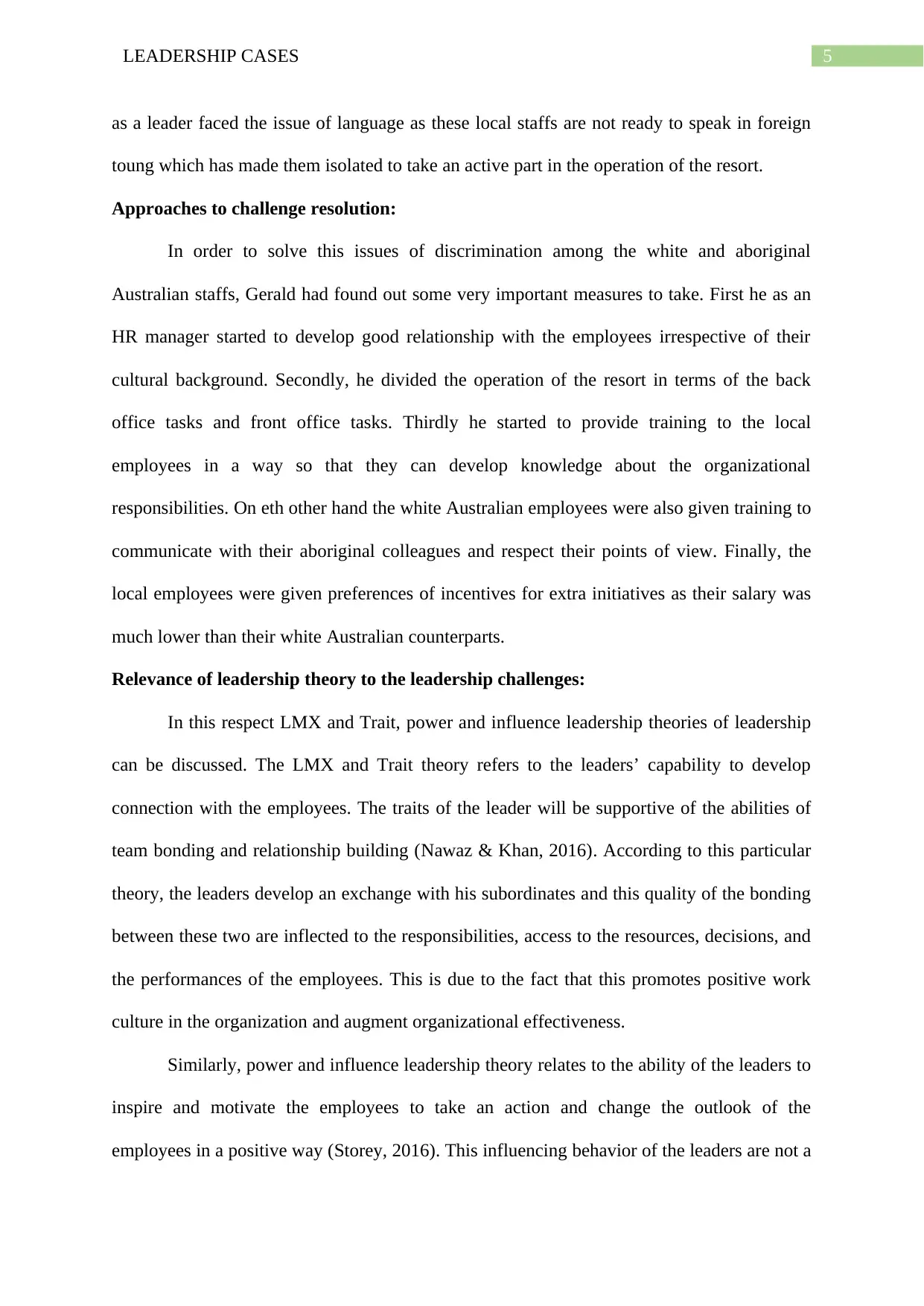
5LEADERSHIP CASES
as a leader faced the issue of language as these local staffs are not ready to speak in foreign
toung which has made them isolated to take an active part in the operation of the resort.
Approaches to challenge resolution:
In order to solve this issues of discrimination among the white and aboriginal
Australian staffs, Gerald had found out some very important measures to take. First he as an
HR manager started to develop good relationship with the employees irrespective of their
cultural background. Secondly, he divided the operation of the resort in terms of the back
office tasks and front office tasks. Thirdly he started to provide training to the local
employees in a way so that they can develop knowledge about the organizational
responsibilities. On eth other hand the white Australian employees were also given training to
communicate with their aboriginal colleagues and respect their points of view. Finally, the
local employees were given preferences of incentives for extra initiatives as their salary was
much lower than their white Australian counterparts.
Relevance of leadership theory to the leadership challenges:
In this respect LMX and Trait, power and influence leadership theories of leadership
can be discussed. The LMX and Trait theory refers to the leaders’ capability to develop
connection with the employees. The traits of the leader will be supportive of the abilities of
team bonding and relationship building (Nawaz & Khan, 2016). According to this particular
theory, the leaders develop an exchange with his subordinates and this quality of the bonding
between these two are inflected to the responsibilities, access to the resources, decisions, and
the performances of the employees. This is due to the fact that this promotes positive work
culture in the organization and augment organizational effectiveness.
Similarly, power and influence leadership theory relates to the ability of the leaders to
inspire and motivate the employees to take an action and change the outlook of the
employees in a positive way (Storey, 2016). This influencing behavior of the leaders are not a
as a leader faced the issue of language as these local staffs are not ready to speak in foreign
toung which has made them isolated to take an active part in the operation of the resort.
Approaches to challenge resolution:
In order to solve this issues of discrimination among the white and aboriginal
Australian staffs, Gerald had found out some very important measures to take. First he as an
HR manager started to develop good relationship with the employees irrespective of their
cultural background. Secondly, he divided the operation of the resort in terms of the back
office tasks and front office tasks. Thirdly he started to provide training to the local
employees in a way so that they can develop knowledge about the organizational
responsibilities. On eth other hand the white Australian employees were also given training to
communicate with their aboriginal colleagues and respect their points of view. Finally, the
local employees were given preferences of incentives for extra initiatives as their salary was
much lower than their white Australian counterparts.
Relevance of leadership theory to the leadership challenges:
In this respect LMX and Trait, power and influence leadership theories of leadership
can be discussed. The LMX and Trait theory refers to the leaders’ capability to develop
connection with the employees. The traits of the leader will be supportive of the abilities of
team bonding and relationship building (Nawaz & Khan, 2016). According to this particular
theory, the leaders develop an exchange with his subordinates and this quality of the bonding
between these two are inflected to the responsibilities, access to the resources, decisions, and
the performances of the employees. This is due to the fact that this promotes positive work
culture in the organization and augment organizational effectiveness.
Similarly, power and influence leadership theory relates to the ability of the leaders to
inspire and motivate the employees to take an action and change the outlook of the
employees in a positive way (Storey, 2016). This influencing behavior of the leaders are not a
⊘ This is a preview!⊘
Do you want full access?
Subscribe today to unlock all pages.

Trusted by 1+ million students worldwide
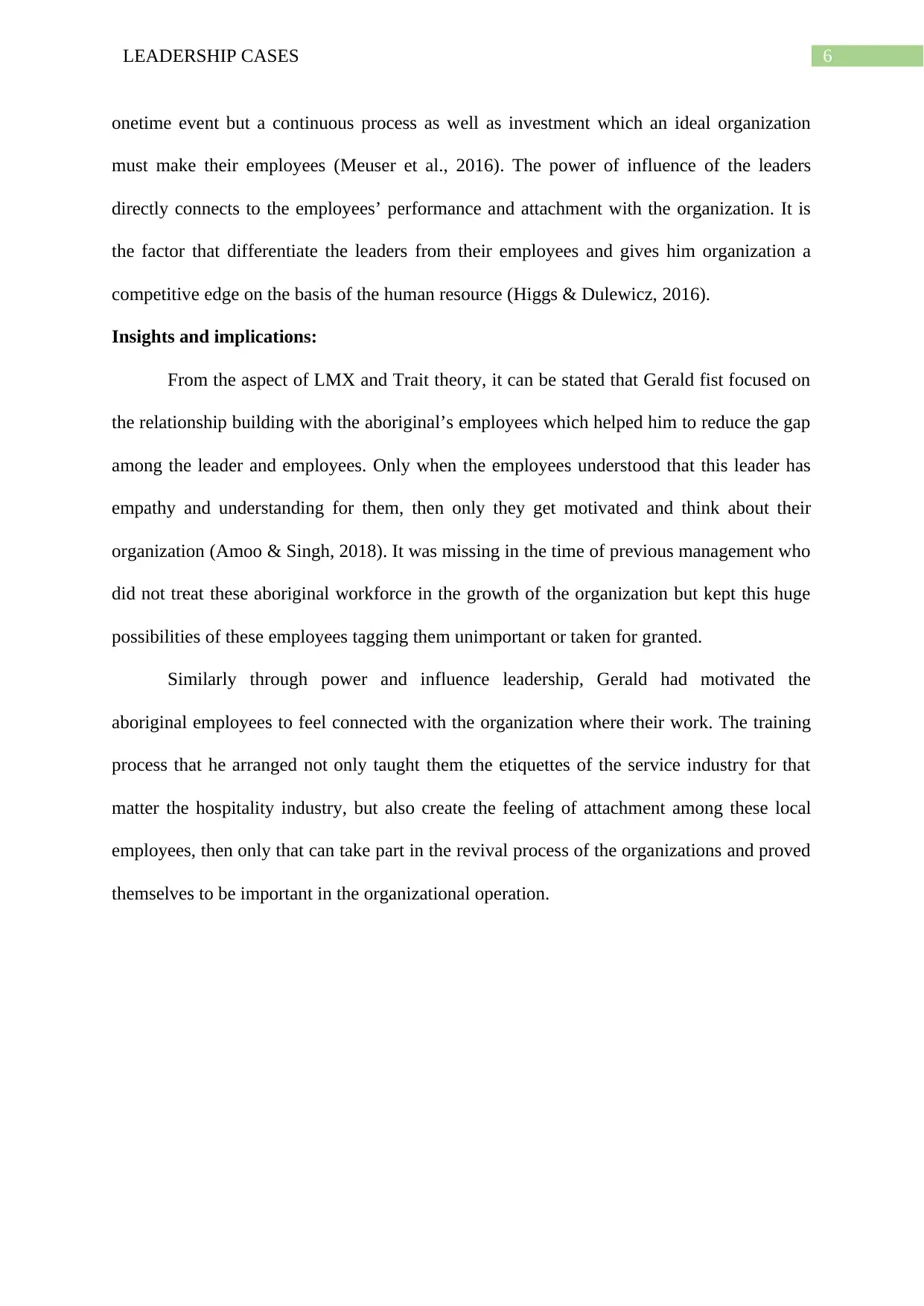
6LEADERSHIP CASES
onetime event but a continuous process as well as investment which an ideal organization
must make their employees (Meuser et al., 2016). The power of influence of the leaders
directly connects to the employees’ performance and attachment with the organization. It is
the factor that differentiate the leaders from their employees and gives him organization a
competitive edge on the basis of the human resource (Higgs & Dulewicz, 2016).
Insights and implications:
From the aspect of LMX and Trait theory, it can be stated that Gerald fist focused on
the relationship building with the aboriginal’s employees which helped him to reduce the gap
among the leader and employees. Only when the employees understood that this leader has
empathy and understanding for them, then only they get motivated and think about their
organization (Amoo & Singh, 2018). It was missing in the time of previous management who
did not treat these aboriginal workforce in the growth of the organization but kept this huge
possibilities of these employees tagging them unimportant or taken for granted.
Similarly through power and influence leadership, Gerald had motivated the
aboriginal employees to feel connected with the organization where their work. The training
process that he arranged not only taught them the etiquettes of the service industry for that
matter the hospitality industry, but also create the feeling of attachment among these local
employees, then only that can take part in the revival process of the organizations and proved
themselves to be important in the organizational operation.
onetime event but a continuous process as well as investment which an ideal organization
must make their employees (Meuser et al., 2016). The power of influence of the leaders
directly connects to the employees’ performance and attachment with the organization. It is
the factor that differentiate the leaders from their employees and gives him organization a
competitive edge on the basis of the human resource (Higgs & Dulewicz, 2016).
Insights and implications:
From the aspect of LMX and Trait theory, it can be stated that Gerald fist focused on
the relationship building with the aboriginal’s employees which helped him to reduce the gap
among the leader and employees. Only when the employees understood that this leader has
empathy and understanding for them, then only they get motivated and think about their
organization (Amoo & Singh, 2018). It was missing in the time of previous management who
did not treat these aboriginal workforce in the growth of the organization but kept this huge
possibilities of these employees tagging them unimportant or taken for granted.
Similarly through power and influence leadership, Gerald had motivated the
aboriginal employees to feel connected with the organization where their work. The training
process that he arranged not only taught them the etiquettes of the service industry for that
matter the hospitality industry, but also create the feeling of attachment among these local
employees, then only that can take part in the revival process of the organizations and proved
themselves to be important in the organizational operation.
Paraphrase This Document
Need a fresh take? Get an instant paraphrase of this document with our AI Paraphraser
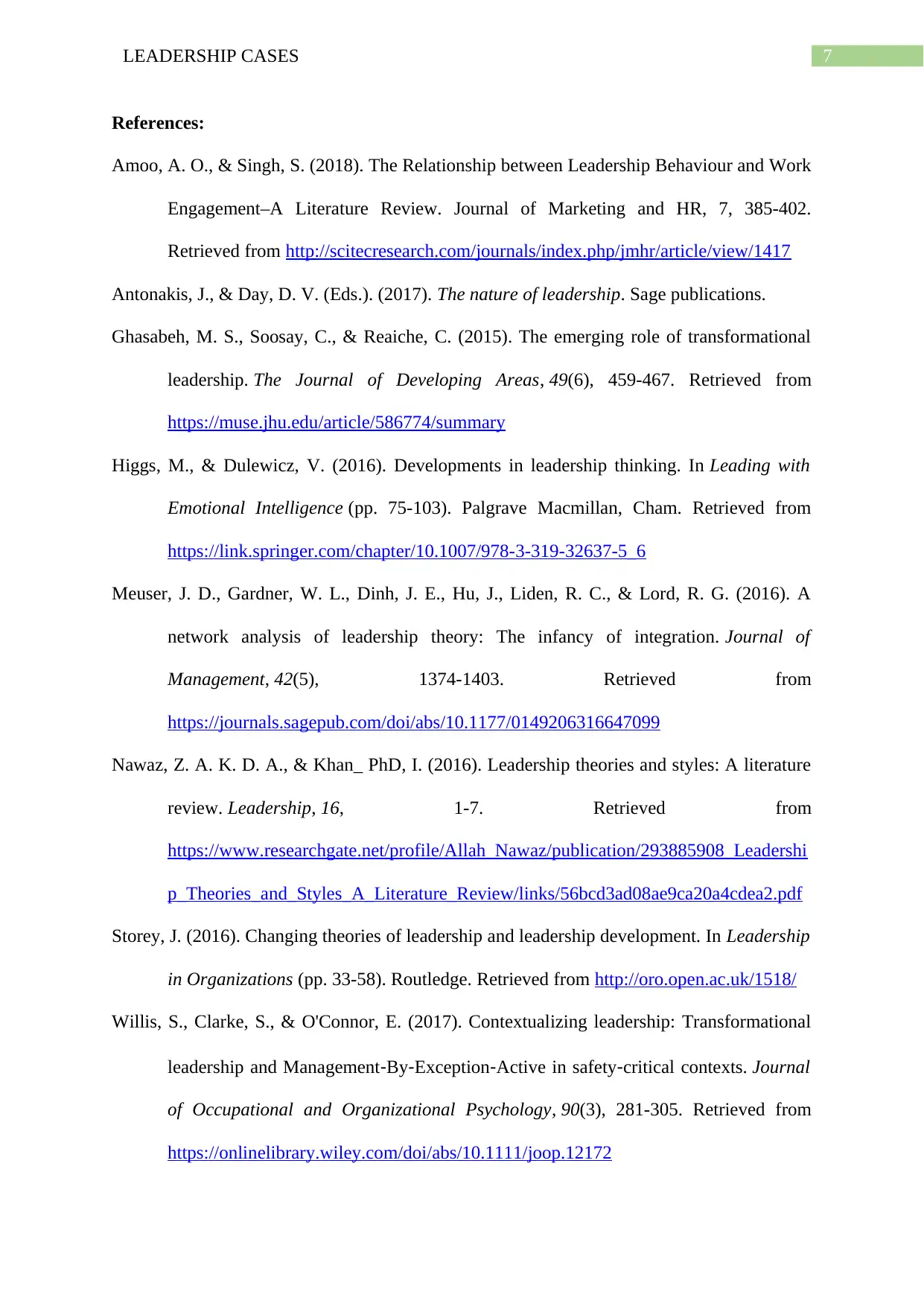
7LEADERSHIP CASES
References:
Amoo, A. O., & Singh, S. (2018). The Relationship between Leadership Behaviour and Work
Engagement–A Literature Review. Journal of Marketing and HR, 7, 385-402.
Retrieved from http://scitecresearch.com/journals/index.php/jmhr/article/view/1417
Antonakis, J., & Day, D. V. (Eds.). (2017). The nature of leadership. Sage publications.
Ghasabeh, M. S., Soosay, C., & Reaiche, C. (2015). The emerging role of transformational
leadership. The Journal of Developing Areas, 49(6), 459-467. Retrieved from
https://muse.jhu.edu/article/586774/summary
Higgs, M., & Dulewicz, V. (2016). Developments in leadership thinking. In Leading with
Emotional Intelligence (pp. 75-103). Palgrave Macmillan, Cham. Retrieved from
https://link.springer.com/chapter/10.1007/978-3-319-32637-5_6
Meuser, J. D., Gardner, W. L., Dinh, J. E., Hu, J., Liden, R. C., & Lord, R. G. (2016). A
network analysis of leadership theory: The infancy of integration. Journal of
Management, 42(5), 1374-1403. Retrieved from
https://journals.sagepub.com/doi/abs/10.1177/0149206316647099
Nawaz, Z. A. K. D. A., & Khan_ PhD, I. (2016). Leadership theories and styles: A literature
review. Leadership, 16, 1-7. Retrieved from
https://www.researchgate.net/profile/Allah_Nawaz/publication/293885908_Leadershi
p_Theories_and_Styles_A_Literature_Review/links/56bcd3ad08ae9ca20a4cdea2.pdf
Storey, J. (2016). Changing theories of leadership and leadership development. In Leadership
in Organizations (pp. 33-58). Routledge. Retrieved from http://oro.open.ac.uk/1518/
Willis, S., Clarke, S., & O'Connor, E. (2017). Contextualizing leadership: Transformational
leadership and Management‐By‐Exception‐Active in safety‐critical contexts. Journal
of Occupational and Organizational Psychology, 90(3), 281-305. Retrieved from
https://onlinelibrary.wiley.com/doi/abs/10.1111/joop.12172
References:
Amoo, A. O., & Singh, S. (2018). The Relationship between Leadership Behaviour and Work
Engagement–A Literature Review. Journal of Marketing and HR, 7, 385-402.
Retrieved from http://scitecresearch.com/journals/index.php/jmhr/article/view/1417
Antonakis, J., & Day, D. V. (Eds.). (2017). The nature of leadership. Sage publications.
Ghasabeh, M. S., Soosay, C., & Reaiche, C. (2015). The emerging role of transformational
leadership. The Journal of Developing Areas, 49(6), 459-467. Retrieved from
https://muse.jhu.edu/article/586774/summary
Higgs, M., & Dulewicz, V. (2016). Developments in leadership thinking. In Leading with
Emotional Intelligence (pp. 75-103). Palgrave Macmillan, Cham. Retrieved from
https://link.springer.com/chapter/10.1007/978-3-319-32637-5_6
Meuser, J. D., Gardner, W. L., Dinh, J. E., Hu, J., Liden, R. C., & Lord, R. G. (2016). A
network analysis of leadership theory: The infancy of integration. Journal of
Management, 42(5), 1374-1403. Retrieved from
https://journals.sagepub.com/doi/abs/10.1177/0149206316647099
Nawaz, Z. A. K. D. A., & Khan_ PhD, I. (2016). Leadership theories and styles: A literature
review. Leadership, 16, 1-7. Retrieved from
https://www.researchgate.net/profile/Allah_Nawaz/publication/293885908_Leadershi
p_Theories_and_Styles_A_Literature_Review/links/56bcd3ad08ae9ca20a4cdea2.pdf
Storey, J. (2016). Changing theories of leadership and leadership development. In Leadership
in Organizations (pp. 33-58). Routledge. Retrieved from http://oro.open.ac.uk/1518/
Willis, S., Clarke, S., & O'Connor, E. (2017). Contextualizing leadership: Transformational
leadership and Management‐By‐Exception‐Active in safety‐critical contexts. Journal
of Occupational and Organizational Psychology, 90(3), 281-305. Retrieved from
https://onlinelibrary.wiley.com/doi/abs/10.1111/joop.12172
1 out of 8
Related Documents
Your All-in-One AI-Powered Toolkit for Academic Success.
+13062052269
info@desklib.com
Available 24*7 on WhatsApp / Email
![[object Object]](/_next/static/media/star-bottom.7253800d.svg)
Unlock your academic potential
Copyright © 2020–2025 A2Z Services. All Rights Reserved. Developed and managed by ZUCOL.





